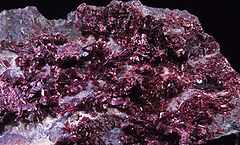Erythrite
| Erythrite | |
|---|---|
|
Erythrite crystals | |
| General | |
| Category |
Arsenate mineral Vivianite group |
| Formula (repeating unit) | Co3(AsO4)2·8H2O |
| Strunz classification | 08.CE.40 |
| Dana classification | 40.03.06.03 |
| Identification | |
| Color | Crimson to peach-red, pale rose, or pink, may be zoned |
| Crystal habit | Radial or stellate aggregates, fibrous, drusy; usually powdery and massive - rarely as striated prismatic crystals |
| Crystal system | Monoclinic - Prismatic H-M Symbol (2/m) Space Group: 2/m |
| Cleavage | Perfect on {010}; poor on {100} and {102}. |
| Tenacity | Sectile |
| Mohs scale hardness | 1.5 - 2.5 |
| Luster | Subadamantine, pearly on cleavages |
| Streak | Pale red to pink |
| Diaphaneity | Transparent to translucent |
| Specific gravity | 3.06 |
| Optical properties | Biaxial (+) |
| Refractive index | nα = 1.626 - 1.629 nβ = 1.662 - 1.663 nγ = 1.699 - 1.701 |
| Birefringence | δ = 0.073 |
| Pleochroism | Visible: X = pale pinkish to pale rose; Y = pale violet to pale violet-rose; Z = deep red |
| References | [1][2][3] |
Erythrite or red cobalt is a secondary hydrated cobalt arsenate mineral with the formula (Co3(AsO4)2·8H2O). Erythrite and annabergite (Ni3(AsO4)2·8H2O) (nickel arsenate) form a complete series with the general formula (Co,Ni)3(AsO4)2·8H2O.

Erythrite crystallizes in the monoclinic system and forms prismatic crystals. The color is crimson to pink and occurs as a secondary coating known as cobalt bloom on cobalt arsenide minerals. Well-formed crystals are rare, with most of the mineral manifesting in crusts or small reniform aggregates.
Erythrite was first described in 1832 for an occurrence in Grube Daniel, Schneeberg, Saxony,[3] and takes its name from the Greek έρυθρος (erythros), meaning red.[2] Historically, erythrite itself has not been an economically important mineral, but the prospector may use it as a guide to associated cobalt and native silver.
Erythrite occurs as a secondary mineral in the oxide zone of Co–Ni–As bearing mineral deposits. It occurs in association with cobaltite, skutterudite, symplesite, roselite-beta, scorodite, pharmacosiderite, adamite, morenosite, retgersite, and malachite.[1]
Notable localities are Cobalt, Ontario; Schneeberg, Saxony, Germany; Joachimsthal, Czech Republic; Cornwall, England; Bou Azzer, Morocco; the Blackbird mine, Lemhi County, Idaho; Sara Alicia mine, near Alamos, Sonora, Mexico; Mt. Cobalt, Queensland and the Dome Rock copper mine, Mingary, South Australia.[1]
Other varieties
The nickel variety, annabergite, occurs as a light green nickel bloom on nickel arsenides. In addition iron, magnesium and zinc can also substitute for the cobalt position, creating three other minerals: parasymplesite (Fe), hörnesite (Mg) and kottigite (Zn).
References
- ↑ 1.0 1.1 1.2 http://rruff.geo.arizona.edu/doclib/hom/erythrite.pdf Handbook of Mineralogy
- ↑ 2.0 2.1 http://www.mindat.org/min-1407.html Mindat.org
- ↑ 3.0 3.1 http://webmineral.com/data/Erythrite.shtml Webmineral data
- Dana's Manual of Mineralogy ISBN 0-471-03288-3
- Manual of Mineral Science, 22nd Ed. C. Klein.ISBN 0-471-25177-1
- Faye, G H; Nickel, E H (1968). "The origin of pleochroism in erythrite". The Canadian Mineralogist 9: 492–504.
| Wikimedia Commons has media related to Erythrite. |
